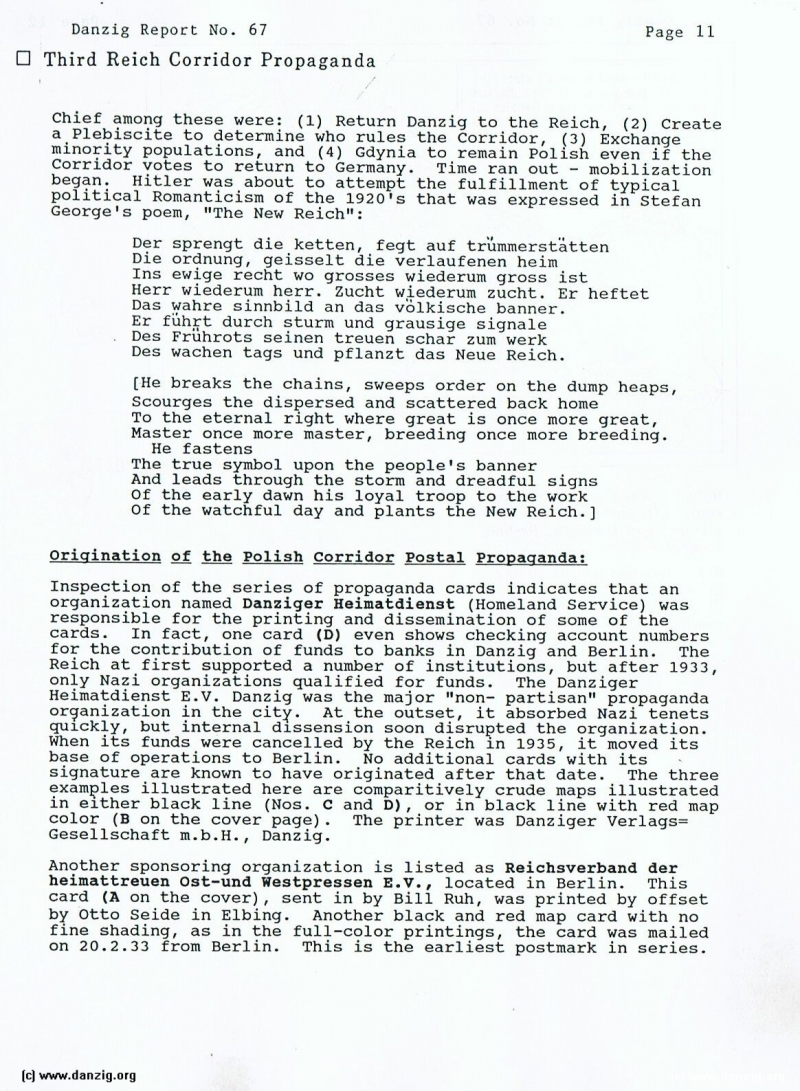
Third Reich Corridor Propaganda
Chief among these were: (1) Return Danzig to the Reich, (2) Create a Plebiscite to determine who rules the Corridor, (3) Exchange minority populations, and (4) Gdynia to remain Polish even if the Corridor votes to return to Germany. Time ran out - mobilization began. Hitler was about to attempt the fulfillment of typical political Romanticism of the 1920’s that was expressed in Stefan George’s poem, “The New Reich”:
Der sprerigt die ketten, fegt auf trZzmmersttten Die ordnung, geisselt die verlaufenen heim Ins ewige recht wo grosses wiederum gross ist Herr wiederum herr. Zucht wiederum zucht. Er heftet Das wahre sinnbild an das volkische banner. Er fuhçt durch sturin und grausige signale Des Fruhrots semen treuen schar zum werk Des wachen tags und pflanzt das Neue Reich.
[He breaks the chains, sweeps order on the dump heaps, Scourges the dispersed and scattered back home To the eternal right where great is once more great, Master once more master, breeding once more breeding.
He fastens The true symbol upon the people’s banner And leads through the storm and dreadful signs Of the early dawn his loyal troop to the work Of the watchful day and plants the New Reich.]
Origination of the Polish Corridor Postal Propaganda:
Inspection of the series of propaganda cards indicates that an organization named Danziger Reimatdienst (Homeland Service) was responsible for the printing and dissemination of some of the cards. In fact, one card (D) even shows checking account numbers for the contribution of funds to banks in Danzig and Berlin. The Reich at first supported a number of institutions, but after 1933, only Nazi organizations qualified for funds. The Danziger Heimatdienst E.V. Danzig was the major “non— partisan” propaganda or9anization in the cit’. At the outset, it absorbed Nazi tenets quickly, but internal dissension soon disrupted the organization. When its funds were cancelled by the Reich in 1935, it moved its base of operations to Berlin. No additional cards with its signature are known to have originated after that date. The three exaniles illustrated here are cornparitively crude maps illustrated in either black line (Nos. C and D), or in black line with red map color (B on the cover page). The printer was Danziger Verlags= Gesellschaft m.b.H., Danzig.
Another sponsoring organization is listed as Reichsverband der heimattreuen Ost—und Westpressen E.V., located in Berlin. This card (A on the cover), sent in by Bill Ruh, was printed by offset by Otto Seide in Elbing. Another black and red map card with no fine shading, as in the full-color printings, the card was mailed on 20.2.33 from Berlin. This is the earliest postmark in series.
Danzig Report Vol. 1 - Nr. 67 - April - May - June - 1990, Page 11.
Hits: 3276
Added: 29/06/2015
Copyright: 2025 Danzig.org

